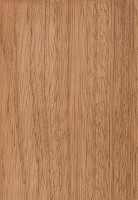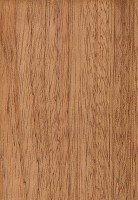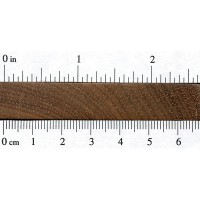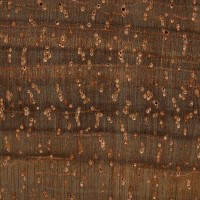 |
Common Name(s): Nyatoh
Scientific Name: Palaquium spp., Payena spp. Distribution: India through Southeast Asia to the Philippines, New Guinea, and the Western Pacific Islands Tree Size: 100-130 ft (30-40 m) tall, 2-3 ft (.6-1 m) trunk diameter Average Dried Weight: 39 lbs/ft3 (620 kg/m3) Specific Gravity (Basic, 12% MC): .53, .62 Janka Hardness: 1,070 lbf (4,760 N) Modulus of Rupture: 13,920 lbf/in2 (96.0 MPa) Elastic Modulus: 1,939,000 lbf/in2 (13.37 GPa) Crushing Strength: 7,890 lbf/in2 (54.4 MPa) Shrinkage: Radial: 3.2%, Tangential: 5.5%, Volumetric: 8.7%, T/R Ratio: 1.7 |
Color/Appearance: Heartwood can be pale pink to reddish or purplish brown. Sapwood is lighter colored, and not clearly delineated from heartwood.
Grain/Texture: Has a typically straight to shallowly interlocking grain. Texture is moderately fine.
Endgrain: Diffuse-porous; medium to very large pores in radial or diagonal arrangement, very few to few; commonly in radial multiples of 2-3; tyloses and other reddish brown gum deposits occasionally present; growth rings indistinct; narrow rays not visible without lens, spacing normal to fairly close; parenchyma diffuse-in-aggregates, and depending on species, marginal.
Rot Resistance: Rated as non-durable and is susceptible to insect attack.
Workability: Some species within these genera have high silica content and will rapidly dull cutting edges. Those not containing silica work fairly easily, though there still tends to be gum buildup on tools.
Odor: Reported to give off a sour smell when being worked.
Allergies/Toxicity: Working with Nyatoh has been reported to cause irritation to mucous membranes. See the articles Wood Allergies and Toxicity and Wood Dust Safety for more information.
Pricing/Availability: Nyatoh is considered a utility wood in the native regions where it grows. It is not commonly seen or sold in the United States.
Sustainability: Nyatoh is not listed in the CITES Appendices, but a number of species in the Palaquium genus are on the IUCN Red List; most are listed as vulnerable due to a population reduction of over 20% in the past three generations, caused by a decline in its natural range, and exploitation.
Common Uses: Furniture, plywood, and interior joinery.
Comments: The two genera, Palaquium and Payene, are closely related and have very similar characteristics: though when dealing with specific data, (as seen above), it only reflects the average values from a number of species. A latex material called gutta-percha has been harvested from trees in the Palaquium genus, though its use today has been largely supplanted by synthetic materials.
None available.








My ears do hear a difference in woods, depending on the grain. Tight grain in a hardwood will promote higher frequencies, while a softer, larger grain will promote lower frequencies. Fine, straight, even grained Sitka Spruce is brighter and better balanced than Cedar, which has a softer, warmer tone. Buy what your ears prefer. My one piece even grained Mahogany Hamer Special sounds very noticeably better than my boutique Brubaker that is made of Paulonia, with the same pickups. Think too, that a tropical hardwood has no “rings”, because it grows year round, while something like Southern Ash has lots… Read more »
Tone is in the fingers , if Jeff beck had picked up a nyatoh body squire and played ´ it would sound like him ´ ´ but you’ll never convince people otherwise ,
Tone is not in the hands / fingers. EVH will sound like evh on a banjo or ukulele… BUT he will NOT get his Brown sound on them. Also JB was notorious at S Duncan pups.
I cant stand the sound of the HB fusion with Nyatoh body. It’s frequency response is quite unfavorable for musical instruments. This wood should be used for flooring and furniture. A guitar is not furniture. It should have a balanced tone
Sounds just fine to me, well made guitar for the $$
To preface this, I have been dealing with electric guitars for around 30 years, and have played (and owned) many vintage and modern guitars, mainly fender and gibson.. is it a oe 59lp, or 54 strat no, but a well made decent sounding guitar (esp after swapping to quality usa pups, and pots/caps)
Indonesia has been do amazing things lately, unlike years ago.
Not only is this a highly subjective matter, the wood used in an electric guitar accounts for only a vanishingly miniscule portion of its sound. Literally 99.99%+ of its sound has to do with the pickups, effects, and amp.
But I understand a bit about human psychology, so I know this issue will never be settled, no matter how many people prove it with blind tests, or with guitars made of metal, plastic, concrete, and even “guitars” that are literally just strings suspended between two supports with a pickup under them.
Exactly. I have ‘blind’ guitar/pickup A/B tests on my YouTube channel……no one has guessed correctly.
Works fine for me, I don’t think wood makes that much difference. Some say it doesn’t matter, some say it makes a big difference. Keep your feet in whichever camp you like but for me, the difference is negligible at best.
What do u think about Ibanez PF15ECE guitar whose sides and back are of nyatoh wood?
Just bought an ibanez rgrt421 neck through body. The wings are made of nyatoh and they seem a little soft, heavy picks are making an impression, but there is only the thinnest layer of black paint on the guitar. Guitar sounds great.
Which wood from South Asia is the best for model making?…..It mainly needs to have a good strength andbe light in weight. Thanks a lot
guys which wood is better for the body of a shred/metal/rock guitar? Nyatoh or Mahoghany? difference in tone? thanks a lot!
Well, fwiw, Ibanez uses it on their Axion Label guitars designed for metal
I’ve just finished an acoustic guitar using nyotah for the back and sides. Haven’t played it yet but the tap tone sounds good.
I’ve seen Nyatoh used on electric guitar necks in a style of guitar that would usually use Mahogany. The Ibanez AS83 uses Nyatoh, and is essentially a copy of a Gibson ES-335, which uses Mahogany. Compared to Mahogany, Nyatoh is a little bit denser (620 vs. 590), but significantly stiffer (13.37 vs. 10.06). The added stiffness makes it great for necks. This is even stiffer than the other wood commonly used for necks, Hard Maple (12.62). This combination of density and stiffness give Nyatoh one of the best sound energy radiation coefficients of the woods commonly used for necks. Nyatoh’s… Read more »
Very useful, thank you. I’ve just purchased an Ibanez AAD300CE-LGS with a ‘ Thermo Aged Nyatoh’ neck. It sounds very good.